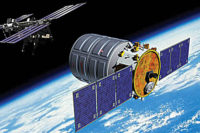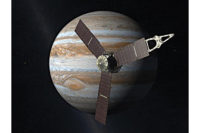A common theme of science fiction is the interconnectedness of things—be they planets, species or technological processes. Real-world space exploration often verifies this view, especially in the area of technology. A good example is NASA’s deep space mission for the Juno spacecraft.
Juno was launched Aug. 5, 2011, and it entered a polar orbit of Jupiter on July 5, 2016. During its long journey, the probe became the fastest human-made object ever (165,000 mph) and reached a height greater than 2,800 miles above Jupiter’s cloud tops. It currently is completing a total of 37 orbits around the planet that will end in early 2018. Research conducted during the orbits focuses on Jupiter’s core materials, its extreme magnetic fields, and how the planet has evolved over millions of years.
Since entering Jupiter’s orbit, Juno has maintained uninterrupted communications with NASA through its Deep Space Network of three 230-foot-diameter parabolic antennas strategically located in Goldstone, CA; Madrid, Spain; and Canberra, Australia. These antennas send control commands to, and receive data and images from, Juno as it orbits Jupiter more than 1 billion kilometers (about 1 light-hour) away from Earth.
The antennas must be precisely positioned to provide reliable, consistent and clear communications. NASA relies on high-performance A2FM45 hydraulic motors from Bosch Rexroth Corp. to ensure accurate positioning.
The motors feature an axial
tapered piston and bent axis design, making them suitable for hydrostatic drives in open and closed circuits. Their output speed (up to 10,000 rpm) depends on motor displacement and pump flow capacity. Output torque increases with the pressure differential between the high and low pressure sides. Besides being compact, the motors are efficient, offer high power density and can be used in mobile applications.
On the Goldstone antenna, which is called the DSS-14 Mars, the motors are located within the rotation assembly. This assembly weighs nearly 8.4 million pounds, and floats and moves on a 0.01-inch-thick film of hydraulic oil known as an azimuth thrust bearing. In 2010, NASA replaced the azimuth bearing, as well as the elevation bearings that help move the antenna up and down.
That same year, Lockheed Martin Space Systems began building Juno in a specially filtered clean room at the company’s Denver facility. Assembly and testing were completed in June 2011.
Juno’s key features include advanced navigation equipment, nine science instruments and a radiation vault to protect its sensitive electronics hub. The vault is six-sided, made of titanium, weighs about 500 pounds and is located on top of the propulsion module. Each titanium wall measures nearly 9 square feet in area, 0.33 inch in thickness and 40 pounds in mass. The vault encloses Juno’s command and data handling box (its brain), power and data distribution unit (its heart), and about 20 other electronic assemblies.
Parts of the electronics are made from tantalum-tungsten, another radiation-resistant metal. In addition, some assemblies are shielded by mini-vaults while others are packed next to each other to enhance protection. Also, engineers wrapped copper and stainless steel braids like chain mail around wires to connect electronics to other parts of the spacecraft.
“[During the many] months Juno orbits Jupiter, the spacecraft will have to withstand the equivalent of more than 100 million dental X-rays,” says Bill McAlpine, Juno’s radiation control manager at NASA’s Jet Propulsion Laboratory. “In the same way human beings need to protect their organs during an X-ray exam, we have to protect Juno’s brain and heart.”
For more information on hydraulic motors, call 610-694-8352 or visit www.boschrexroth-us.com.








